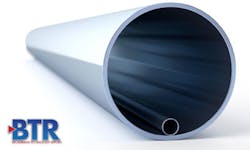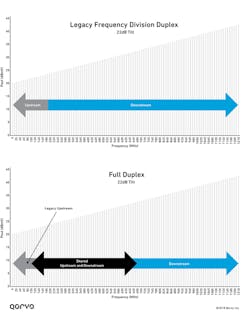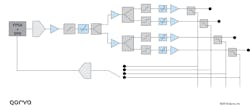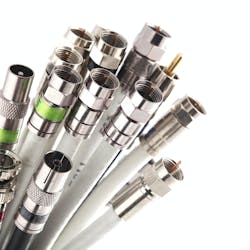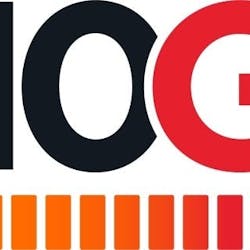There is renewed excitement in the cable market as RF technologies continue to evolve, creating a path for hybrid fiber/coax (HFC) systems to support 10 Gbps data transmission. Fully realizing this potential, however, means making changes to the way the industry approaches architecture, which in turn requires new technology and techniques. Here are some of the technology challenges and considerations as HFC marches toward the 10 gigabit future.
Architectural blocks
DOCSIS 3.1 evolution
DOCSIS is a family of international telecommunications standards used by cable MSOs to transfer data over an HFC system. First released in 1997, DOCSIS has evolved to increase data throughput, bandwidth expansion, and higher modulation and complex capability. The first-released DOCSIS 1.0 supported downstream bandwidth of 550 MHz with a data rate of 40 Mbps, and upstream bandwidth of 45 MHz with a data rate of 10 Mbps.
As demand for higher data rates and complex content management continues, DOCSIS has been amended and new specifications are being defined. The latest version, DOCSIS 3.1 - released in 2013 and revised several times since - is targeted to support 10 Gbps downstream and 1 Gbps upstream (10 Gbps symmetrically in full-duplex application) using 4,096-QAM (quadrature amplitude modulation) and orthogonal frequency division multiplexing (OFDM) modulation techniques.
From the RF point of view, the catch to achieving 10 Gbps is well-understood: The performance of RF degrades as operating frequency is increased and bandwidth is expanded. How, then, can RF performance such as output power, gain and linearity be improved while maintaining overall power consumption?
To achieve this, a new semiconductor technology, gallium nitride (GaN), was developed and has become the default technology for DOCSIS 3.1 amplifiers. Compared to gallium arsenide (GaAs), the predecessor technology used in HFC, GaN offers higher power density, wider bandwidth, improved efficiency and greater reliability. It can also operate at a higher channel temperature.
In the circuit design, new functions are integrated into the products to customize power management, gain control and temperature sensing.
Fiber Deep, N+0
The first step in supporting 10 Gbps requires an architecture change that involves the optical node - moving it closer to the subscriber and eliminating additional amplifiers that were used to compensate for cable losses in a traditional architecture.
Benefits offered by having the node closer to the customer include reducing the number of subscribers per node to deliver better service and eliminating the need for many amplifiers following the node, thereby reducing installation and maintenance costs.
By eliminating the amplifiers following the nodes for additional correction, one of the key impacts on RF components is the need for increased output power on the last power doubler RF amplifier to 76.8 dBmV composite power - 3 dB higher than in a traditional HFC architecture. In order to achieve this, new broadband-targeted GaN technology was developed that leverages the power density and efficiency of this technology. Furthermore, this solution required changing the legacy 24V amplifier's operating voltage to 34V. As a result, the overall power consumption increased 80%, from 10W to 18W per amplifier.
DAA - Remote PHY/Remote MAC PHY
Remote PHY/Remote MAC PHY is the next step toward symmetrical 10 Gbps service. In a similar fashion to Fiber Deep, Distributed Access Architecture (DAA) is moving some of the functions closer to subscribers.
There are currently several versions of DAA:
1. Remote PHY, with an RF-creation piece like edge QAM that manages video on demand (VOD) and switched digital video (SDV)
2. Remote MAC PHY, where media access control packet-level processing is included
3. Remote CCAP, which basically moves all CCAP function from the headend CMTS to inside the node
One of the key changes with a Remote PHY device (RPD) in the node is the change from analog amplitude modulation (AM) to digital (Ethernet) mode. Digital optics and RPD modules provide cost and size advantages in installation and upgrades.
Which of the three options is considered best? Since there are different structures and capabilities of existing CCAP solutions, there will be some variations in the solutions. The end goal, however, is providing the stepping-stone to the 10 Gb future.
DOCSIS 3.1 Full Duplex
Even with DAA and bandwidth expansion to 1.2 GHz, achieving 10 Gbps in both downstream and upstream is impossible without additional changes. To address this, Full Duplex (FDX) architecture was introduced in 2016. The essential purpose of an FDX system is to share portions of the frequency (100 MHz to 684 MHz) for both downstream and upstream data transmission.
Figure 1 below shows the downstream and upstream frequency spectrum in traditional and FDX applications.
New techniques to support architectural changes
Power budget and PA efficiency improvement
One of the key challenges of adding functions inside the node is the power consumption limitation. Today, the power budget for the North America node is roughly 160W. By adding functions inside the node, like RPD or RPD MAC PHY, plus having the high output power amplifiers to support Fiber Deep and FDX applications, MSOs are running into power management issues.
To address power management and reduce power consumption in the node, digital predistortion (DPD), a technique that is widely used in the wireless market, is being developed for HFC. The goal is to reduce the overall power consumption by applying DPD to the HFC RF component chain while maintaining the key specifications of the amplifier such as output power, gain and linearity.
So how does DPD work? In short, DPD models and predicts the non-linear behavior of amplifiers and injects inverse signals before the amplifier, thereby reducing the high current to overcome the non-linear behavior in the amplifier designs. In a typical four-port node, RF amplifiers in the chain consume roughly 85W, of which 72W is from the last power doubler PA. With DPD, results to date indicate that this technique reduces overall power consumption as much as 20%.
Figure 2 below shows non-linear characteristics of an amplifier with and without DPD.
Figure 3 below shows RF lineup including DPD.
Getting to high-volume production
Achieving 20% power savings with DPD is a notable accomplishment. Unfortunately, proving its feasibility is only the first step, and we must now look at how we can make this work in the production setting.
Understanding non-linear contributions from an amplifier and optimizing RF designs is not a trivial task. Amplifier design must be now coupled with DPD, to understand and identify contributing parameters that are correctible with DPD. Furthermore, other factors beyond the design must be sorted out. Matters such as pairing multiple amplifiers - as many as four with similar characteristics - minimizing part-to-part variations, temperature compensation, and memory effects are critical considerations before high-volume production is possible.
RF component changes in FDX
In the FDX application, because of the shared downstream and upstream band, there are two major changes in the RF amplifiers. In the downstream path, the new power doubler PA must now provide 2 dB to 3 dB higher output power to compensate for the additional loss. In the upstream path, legacy 65 MHz to 85 MHz bandwidth is expanded to ~700 MHz. This means developing a new wideband amplifier capable of operating from 5 MHz to 700 MHz with similar stringent specifications.
Embracing the challenges - Preparing the next steps
The legacy cable system that saw incremental changes over many years is no more. Driven by consumer demand for complex services and higher data rates - and to combat alternative technologies like fiber-to-the-home (FTTH) - HFC is setting a new standard for a new era.
Architectures such as DAA and FDX are being introduced and implemented, and proven applications like DPD are being leveraged as part of the overall HFC system. Innovations in RF front-end component technology are playing a key role in driving new architectures, and this new semiconductor technology and associated processes are continuously being evaluated and enhanced.
RF component offerings are expanding into system solutions, where interfacing to the digital domain is part of the overall requirement. As new HFC deployments occur and new challenges are encountered, RF technology stands ready to embrace and support this exciting technology journey.
Kellie Chong is director of the broadband product line at Qorvo (NASDAQ:QRVO).
